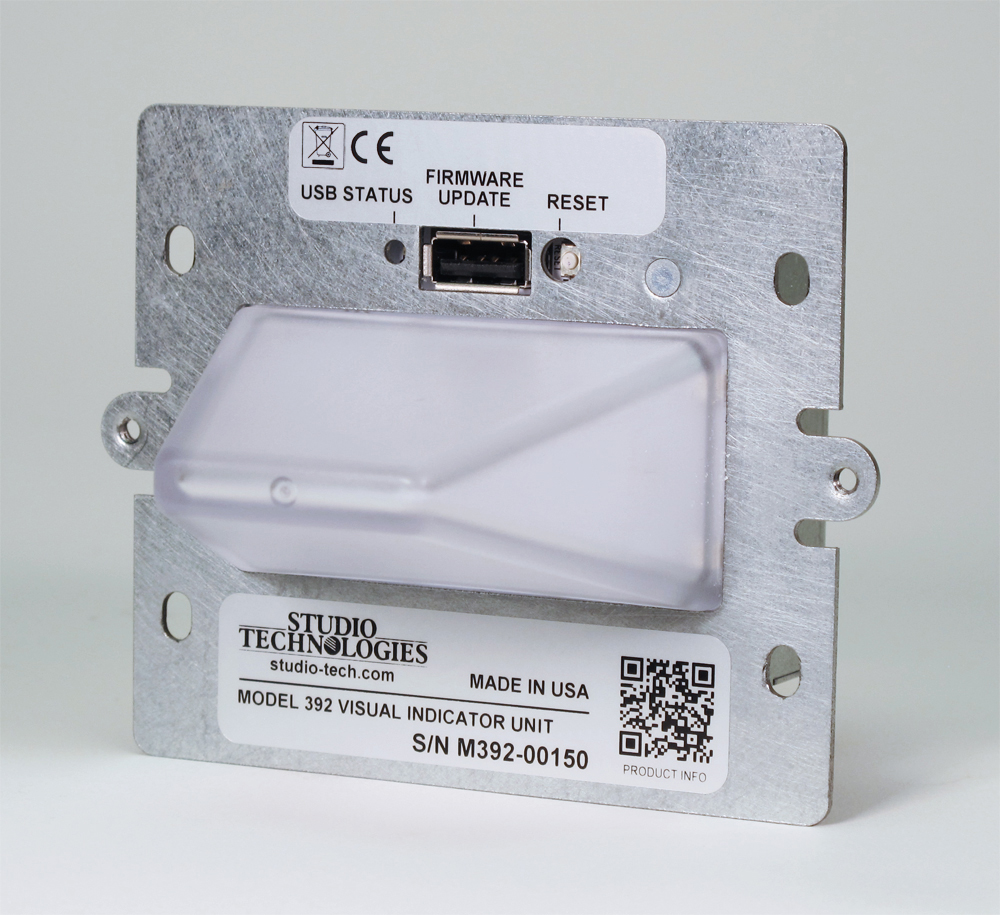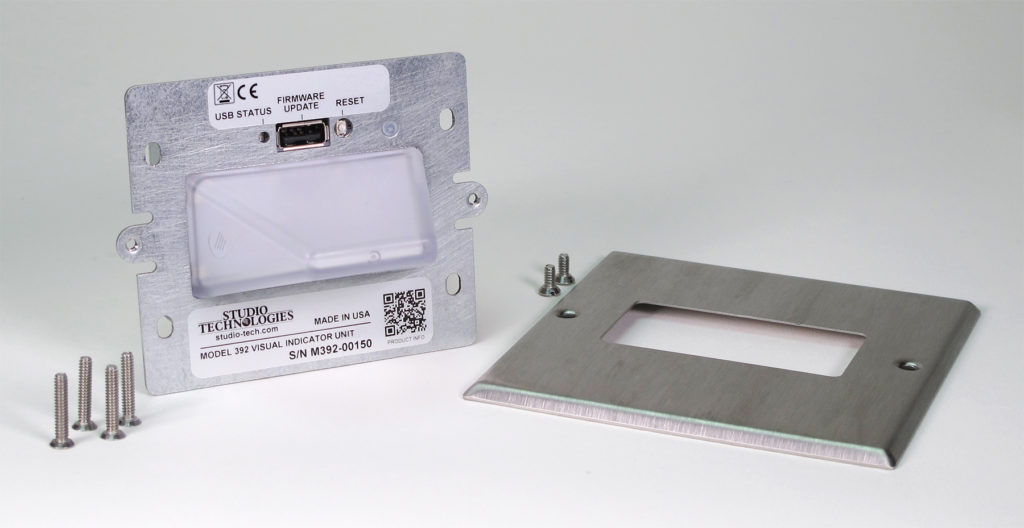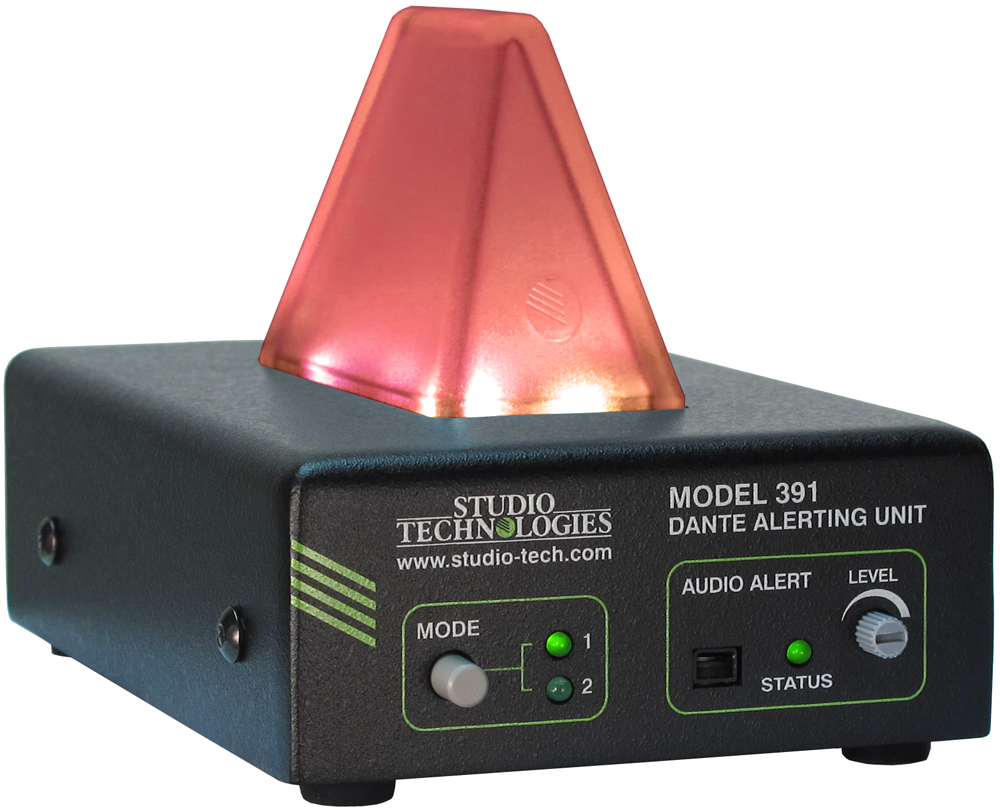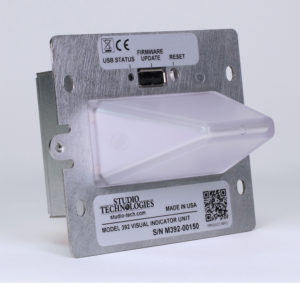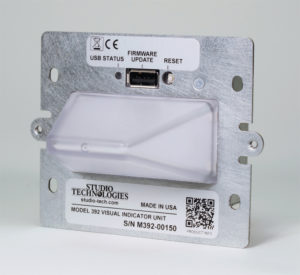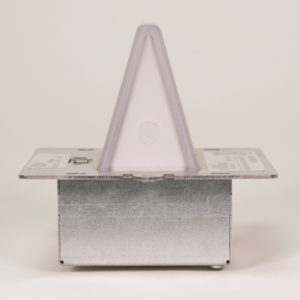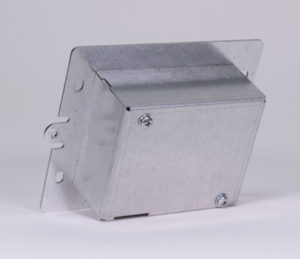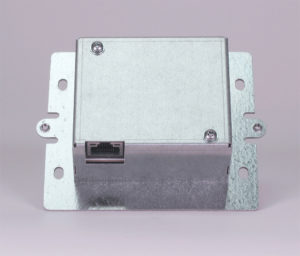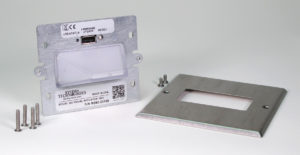The Model 392 is designed for a variety of applications that require a visual status indicator. An array of red/green/blue (RGB) LEDs provide backlighting for a distinctively shaped polycarbonate (plastic) lens assembly. The Model 392 can serve as a broadcast "on-air" light, a room occupied display, or an intercom call signal indicator. In addition, the unit can serve as an audio level display, with a green, yellow, and red indication of audio level. Full operation requires only a Power-over-Ethernet (PoE) 100 Mb/s data connection. It's compatible with the popular Dante® audio-over-Ethernet protocol but offers support for a range of additional applications. Configuration is performed using the Studio Technologies' STcontroller software application. Selected configuration values are stored within the Model 392's non-volatile memory. A variety of methods are provided to allow control of the Model 392's LED array. These include using STcontroller's "virtual" button, receiving network-transported UDP commands, and responding to an audio signal level associated with a Dante digital audio connection.
The Model 392 is a compact, lightweight unit that is primarily intended for fixed applications with mounting in a US-standard 2-gang electrical box or by way of a 2-gang low-voltage mounting bracket. The unit's optical lens conforms to the requirements of a 1-Decora® opening, allowing a 2-gang wall plate with centered 1-Decora opening to be used to complete the "look" of an installation. Standard wall plates are available in a variety of materials and finishes. For convenience, each unit includes a stainless steel wall plate. It's expected that 3rd-party custom wall plates will be created to support the Model 392. These would include the selection of material and text that would support specific applications. The Model 392 can also be used in portable applications by mounting the unit in a 2-gang electrical box intended for surface-mount or outdoor applications. These boxes typically have rugged finishes that would be appropriate for deployment by personnel for temporary use.
Configuration of the Model 392 is performed using the STcontroller software application. Choices include the display activation method, the LED colors, the LED intensity, and the LED action.
Applications
The on and off status of the Model 392's display can be controlled using a "virtual" selection within STcontroller. This is a simple means of controlling the unit, but would require user intervention. While available, in most cases this method will be used only during deployment and testing.
Custom applications can generate UDP commands that can control operation of the Model 392's display. It's expected that a simple software program or routine would be created for use within personal computers, media routers or switchers, or digital matrix devices.
The Model 392 is also directly compatible with the call signals generated by the popular Studio Technologies' Dante-enabled beltpacks and intercom stations. These Dante-connected user devices generate a 20 kHz tone whenever their call button is activated. Model 392 applications can also employ the Studio Technologies' intercom interface units to provide compatibility with legacy analog PL intercom systems. Interface units are available that at compatible with Clear-Com® PL as well as the TW-series from RTS®/Bosch®.
In addition to responding to intercom beltpack call requests, the Model 392 can also be used in other Dante-related applications. These include allowing one of the contact-closure inputs on a Studio Technologies' Model 44D Interface to trigger the display on a Model 392. Being Dante networked audio devices, the Model 392 and Model 44D units will function together as long as they are located on the same network, whether the devices are in the same room or on the opposite sides of a university campus. Another application would be to use signals generated by other products, such as the Studio Technologies' Model 214 and Model 215 Announcer's Consoles, to allow the Model 392 to directly serve as a broadcast "on-air" indicator.
An audio level meter function allows a Model 392 to directly display a visual color and intensity representation of the signal level of a connected Dante audio signal. By simply routing a Dante transmitter (output) audio channel to the Model 392's Dante (receiver) input channel, the unit's display can provide a 3-color indication of the level of the incoming PCM digital audio data. Green is utilized for signals within the normal level range. Yellow is displayed when a signal is within an acceptable level, but greater than what is normal. Red is displayed when a signal is near to, or has reached, the maximum level. Within each level range the intensity of the green, yellow, and red LED display will increase as the input level increases.
Features
The Model 392 incorporates a trapezoidal-prism-shaped polycarbonate lens lit with multiple red/green/blue (RGB) LEDs. The unit is designed for mounting in a 2-gang electrical box with a lens that is compatible with a 1-Decora opening. The unit can also be mounted utilizing a 2-gang low-voltage mounting bracket. Only a single 100BASE-TX with PoE network connection is required. These characteristics makes the unit ideal for deployment in "new build" applications as well as for retrofitting into existing structures. The Model 392's display lens provides a highly visible, wide viewing field. Configuration choices allow selection of the exact color, intensity, and lighting cadence. If desired, the Model 392 can be configured to display a selected color and intensity when the unit has been selected for "off" or inactive. This ensures that the unit's display can always be active, confirming that the unit is operating normally.
Dante Audio-over-Ethernet
Audio and related data is sent to the Model 392 using the Dante audio-over-Ethernet media networking technology. As a Dante-compliant device, the Model 392's Dante receiver (input) audio channel can be assigned (routed) from a source device using the Dante Controller software application. The Model 392 is compatible with Dante digital audio sources that have a sample rate of 48 kHz and a bit depth of up to 24.
Ethernet Data and PoE
The Model 392 connects to an Ethernet data network using a standard 100 Mb/s twisted-pair Ethernet interface. The physical interconnection is made by way of an RJ45 jack. Two LEDs display the status of the Ethernet connection. The Model 392's operating power is provided by way of the Ethernet interface using the 802.3af Power-over-Ethernet (PoE) standard. This allows fast and efficient interconnection with an associated data network. To support PoE power management, the Model 392's PoE interface reports to the power sourcing equipment (PSE) that it's a class 1 (very low power) device.
Setup, Configuration, and Operation
Setup, configuration, and operation of the Model 392 is simple. An RJ45 jack is used to interconnect the unit's network interface with a standard twisted-pair Ethernet cable associated with a port on a PoE-enabled network switch. This connection provides both network data and power. The Model 392's compact enclosure can be mounted into a standard 2-gang electric box. A stainless steel wall plate with a 1-Decora opening is provided with each unit. Custom wall plates can be created if warranted for an installation. This would allow specific finishes and/or labeling to be implemented.
All Model 392 features are configured using the STcontroller personal computer software application. An extensive set of parameters allows the unit's operation to be tailored to meet the needs of many applications. STcontroller, available in versions that will support the Windows® and macOS® operating systems, is a fast and simple means of confirming and revising the unit's operating parameters. The Dante Controller personal computer application will typically be used to route ("subscribe") a Dante audio source to the Model 392's Dante receiver (input) audio channel. However, this is not required as the Model 392 can respond to UDP commands provided by way of the connected Ethernet network.
Future Capabilities and Firmware Updating
The Model 392 was designed so that its capabilities and performance can be enhanced in the future. A USB receptacle, located on the front of the unit (under the wall plate), allows the application firmware (embedded software) to be updated using a USB flash drive.
To implement the Dante interface the Model 392 uses Audinate's UltimoX2™ integrated circuit. The firmware in this integrated circuit can be updated via the Ethernet connection, helping to ensure that its capabilities remain up to date.

